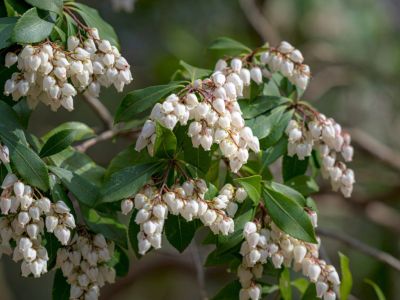Andromeda Plant Info
Japanese andromeda is an evergreen shrub with many uses in the landscape. Use it in shrub groupings or as a foundation plant, or let it stand alone as a specimen plant that few other shrubs can rival. The plant is a bit fussy about soil and light exposure, but if azaleas and camellias do well in the area, Japanese andromeda will probably thrive too. Here are some noteworthy cultivars:
‘Mountain Fire’ features brilliant red foliage on new shoots. ‘Variegata’ has leaves that go through several color changes before they mature to green with white margins. ‘Purity’ is noted for its extra-large, pure white flowers and compact size. It blooms at a younger age than most cultivars. ‘Red Mill’ has flowers that last longer than other cultivars, and the plants are reported to resist the diseases that plague other types.
Pieris Care and Planting
Japanese andromeda grows in USDA plant hardiness zones 5 through 9. The best Pieris japonica growing conditions include a site with full to partial shade and rich, well-drained soil with plenty of organic matter and an acidic pH. If your soil isn’t particularly rich, work in a thick layer of compost before planting. If necessary, amend the soil with an azalea or camellia fertilizer to add nutrients and adjust the pH level. Japanese andromeda bushes won’t tolerate alkaline soil. Plant Japanese andromeda in spring or fall. Set the plant in a hole at the depth at which it grew in its container, and press down with your hands as you backfill the planting hole to eliminate air pockets. Water immediately after planting. If you are planting more than one shrub, allow 6 or 7 feet (1.8 to 2 m.) between them to encourage good air circulation. Japanese andromeda is susceptible to a number of fungal diseases, good air circulation will go a long way toward preventing them. Water the shrub often enough to keep the soil lightly moist at all times. Water slowly, allowing the soil to soak up as much moisture as possible. Fertilize in winter and early summer with a fertilizer designed for acid-loving plants, using the amount recommended on the package. Fertilizers designed for azaleas and camellias are ideal. Japanese andromeda bushes grow to a height of 10 feet (3 m.) unless you plant compact varieties. It has a naturally attractive shape, and it’s best to let it grow without pruning as much as possible. If you need to neaten the plant, however, do so after the flowers fade.
